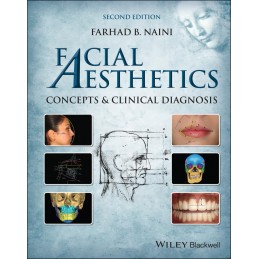- Reduced price

Order to parcel locker

easy pay


 Delivery policy
Delivery policy
Choose Paczkomat Inpost, Orlen Paczka, DHL, DPD or Poczta Polska. Click for more details
 Security policy
Security policy
Pay with a quick bank transfer, payment card or cash on delivery. Click for more details
 Return policy
Return policy
If you are a consumer, you can return the goods within 14 days. Click for more details
The definitive reference on facial aesthetic analysis for aesthetic and reconstructive surgery and aesthetic dentistry
Facial Aesthetics:: Concepts and Clinical Diagnosis is a unique resource for facial aesthetic surgery and dentistry. Providing a comprehensive guide to both the art and science of facial aesthetics, the book incorporates all aspects relevant to the work of the clinician involved in the management of facial deformities. Revised and expanded with extensive additions, the second edition is structured over 24 easy-to-follow chapters with numerous illustrations and diagrams.
Part I of Facial Aesthetics covers the historical evidence for facial aesthetics canons and concepts in depth. It incorporates all aspects relevant to the work of the clinician, including the philosophical and scientific theories of facial beauty, facial attractiveness research, facial proportions, facial expression, and the psychological ramifications of facial deformities. Part II of the book goes on to examine clinical evaluation and diagnosis in considerable detail under four sections, from the initial consultation interview and acquisition of diagnostic records, complete clinical examination and analysis of the craniofacial complex, in-depth analysis of each individual facial region, and the comprising craniodentoskeletal and soft tissue units and subunits, using a top-down approach, and finally focusing on smile and dentogingival aesthetic evaluation.
Written by a highly qualified practitioner and researcher in the field, Facial Aesthetics also provides::
Facial Aesthetics is a comprehensive, practical reference and essential guide for practitioners with interest in refining their understanding and appreciation of the human face and applying practical protocols to their clinical diagnosis and treatment planning. It is essential reading for facial aesthetic surgeons and aesthetic dentists, orthodontists, oral and maxillofacial surgeons, as well as plastic and reconstructive surgeons.
Data sheet
Reviews of the First Edition xvi
Preface to Second Edition xviii
Preface to the First Edition xx
Acknowledgements xxii
Part I Concepts
Chapter 1 Facial Beauty
with Hengameh B. Naini 3
Definition of beauty and aesthetics 3
Is beauty ‘in the eye of the beholder’? 5
The enigma of facial beauty 6
Beauty and facial beauty: historical and philosophical perspectives 11
Facial Beauty: Scientific perspectives 17
Importance of facial beauty 22
Striving for form 23
References 24
Chapter 2 Facial Proportions: Classical Canons to Modern Craniofacial Anthropometry 26
Introduction 26
Ancient Egypt 26
Ancient Greece 27
Ancient Rome 34
The Renaissance 36
The Enlightenment and neoclassicism 51
Twentieth century 53
The golden proportion 55
Conclusion 61
References 61
Chapter 3 Facial Expression: Influence and Significance 63
Introduction 63
Importance of facial expressions 63
History of research into facial expressions 64
References 70
Chapter 4 Psychological Ramifications of Facial Deformities 72
Introduction 72
Health and psychosocial well-being 72
Self-image 73
The effect of the response of others on those with facial deformities 74
To treat or not to treat? The controversial debate 75
Body dysmorphic disorder: the delusion of deformity 76
Managing facial deformity in a neurotic-dysmorphic patient 81
Conclusion 82
References 82
Further reading 83
Part II Clinical Diagnosis
Section 1 Patient Interview and Clinical Diagnostic Records 87
Introduction to Section 1 87
Diagnosis 87
Chapter 5 Patient Interview and Consultation 89
Introduction 89
Presenting complaint 89
History of presenting complaint 90
Psychosocial history 91
Medical history 93
Danger signals and the ‘problem’ patient 93
Concluding remarks 93
References 94
Chapter 6 Clinical Diagnostic Records, Natural Head Position and Craniofacial Anthropometry 95
Introduction 95
Radiographs 95
Clinical photographs 97
Clinical videography 97
Study models 97
Serial height measurement 98
Three-dimensional hard and soft tissue imaging 98
The Frankfort Craniometric Agreement and the Frankfort Plane 99
The unreliability of anatomical reference planes 101
Natural head position: the key to diagnosis 102
Choice of horizontal and vertical reference planes 103
Orientation of the patient in natural head position 104
Equipment for digital photography and data storage 105
Patient consent forms 105
Background and lighting 105
Facial views 106
Intraoral views 107
Anthropometric craniofacial surface landmarks 108
References 112
Chapter 7 Cephalometry and Cephalometric Analysis 113
Introduction 113
Cephalometric landmarks and planes of reference 114
Landmarks, lines, planes and volumes 114
Cephalometric planes of reference 119
Posteroanterior cephalometric radiography 122
Cephalometric analysis and geometric principles 125
Description of dentofacial deformities 125
Sagittal skeletal relationships 127
Sagittal dentoalveolar relationships 137
Vertical skeletal relationships 142
Vertical dentoalveolar relationships 148
Transverse skeletal relationships 149
References 149
Section 2 Facial Aesthetic Analysis: Facial Type, Proportions and Symmetry 151
Introduction to Section 2 151
The diagnostic process – clinical evaluation 152
Clinical evaluation – the sequence 154
References 155
Chapter 8 Facial Type 157
Introduction 157
The fictional conception of the ‘normal’ 157
Proportion indices 157
Head type 159
Cephalic index 159
Head circumference 160
Facial type: frontal view (norma frontalis) 160
Facial shape 160
Facial index 161
Facial type: profile view (norma lateralis) 162
Facial divergence 162
Sagittal facial profile contour 164
Parasagittal facial profile contour 167
Facial curves and curvilinear relationships 171
Curvilinear relationships – frontal and profile views 172
Angularity of facial contour lines 172
Facial profile curves and ‘S-shaped’ curvilinear considerations 172
Contour defects 173
Sexual variation: the main differences between male and female faces 174
‘Ethnic’ variation: considerations in facial aesthetic evaluation 175
Historical background 175
Considerations in facial aesthetic evaluation 175
Clinical implications 176
Facial ageing 178
Current understanding, controversies and future research 179
Recognizing the visible effects of ageing 181
References 182
Chapter 9 Facial Proposition 184
Introduction 184
Craniofacial height to standing height proportion 185
Vertical Facial Proportions 190
Transverse facial proportions 194
Concluding remarks 198
References 198
Chapter 10 Facial Symmetry and Asymmetry 199
Introduction 199
Relationship between symmetry and proportion 199
Balance and harmony: a note on terminology 200
Aetiology and classification of facial asymmetry 200
Clinical evaluation 201
Dynamic clinical evaluation 206
Dental midlines 209
Radiographic/cephalometric evaluation 210
Three-dimensional imaging evaluation 214
Craniofacial growth and treatment timing 218
References 222
Section 3 Facial Aesthetic Analysis: Regional Analysis 223
Introduction to Section 3 223
The modified subunit principle 223
Relativity and the five facial prominences 224
References 225
Upper Facial Analysis 226
Chapter 11 The Forehead 227
Introduction and Terminology 227
Anatomy 227
Clinical evaluation 228
References 232
Chapter 12 The Orbital Region 233
Introduction 233
Terminology 234
Anatomy 234
Clinical evaluation 236
References 240
Midfacial Analysis 242
Chapter 13 The Ears 243
Introduction 243
Terminology 243
Anatomy 243
Clinical evaluation 244
References 248
Chapter 14 The Nose 249
Introduction 249
Terminology 251
Anatomy 252
Nasal type, topography and the subunit principle 254
Clinical evaluation 257
Normative values for nasal dimensions 271
Nasal function 272
References 272
Chapter 15 The Malar Region 274
Introduction 274
Terminology 274
Anatomy 275
Clinical evaluation 275
Principles in planning the correction of malar deficiency 280
References 282
Chapter 16 The Maxilla and Midface 283
Introduction 283
Terminology 283
Anatomy 286
Clinical evaluation 288
Maxillary deficiency 297
Maxillary excess 301
Maxillary asymmetry 305
References 306
Lower Facial Analysis 307
Introduction 307
Chapter 17 The Lips 308
Introduction 308
Anatomy 308
Terminology 310
Clinical evaluation 310
References 326
Chapter 18 Mentolabial (Labiomental) Fold 328
Introduction 328
Mentolabial fold (sulcus) depth 328
Mentolabial angle 328
Attractiveness research 331
Vertical position of the mentolabial fold 331
Mentolabial fold morphology 331
References 334
Chapter 19 The Mandible 335
Terminology 335
Anatomy, morphology and size 335
Sagittal and vertical relationships 339
Mandibular deficiency 339
Mandibular excess 342
Transverse relationships 346
Mandibular asymmetries 347
References 352
Chapter 20 The Chin 353
Introduction 353
Anatomy 353
Terminology 354
Classification of chin deformities 359
Clinical evaluation 362
Sagittal evaluation and chin projection 362
Sagittal position of hard tissue (skeletal) pogonion 367
Indirect morphological influences on sagittal chin projection 369
Soft tissue chin pad 370
Mentolabial fold and chin pad morphology 370
Dynamic chin pad evaluation 370
Mentalis muscle – anatomy, activity and significance 371
Vertical chin height 374
Transverse chin width 374
References 375
Chapter 21 Submental-Cervical Region 377
Introduction 377
Anatomy 377
Terminology 377
Aetiology 378
Clinical evaluation 379
Relative submental projection and aesthetics 391
References 391
Section 4 Smile and Dentogingival Aesthetic Analysis 393
Introduction to Section 4 393
Chapter 22 Dental-Occlusal Relationships: Terminology, Description and Classification 395
Introduction 395
Terminology 395
Dental occlusion 397
Classification of dental-occlusal relationships 400
The term ‘Class’ and classification 404
The aetiology of malocclusion 406
Oral health 409
Occlusal function 410
References 410
Chapter 23 Smile Aesthetics
with Daljit S. Gill 412
Introduction 412
Clinical evaluation 413
Lip aesthetics 413
Lip lines 413
Upper lip–maxillary incisor relationship 414
Incisor exposure and phonetic analysis 418
Incisor exposure in oblique lateral view 419
Incisor exposure and anterior occlusal guidance 419
Smile symmetry 420
Dynamic upper lip curvature 420
Orientation of the transverse occlusal plane 420
Orientation of the sagittal occlusal plane 421
Smile curvature (smile arc) 421
Dental midlines 425
Buccal corridors (negative space) 425
Smile aesthetics in profile view 427
References 431
Chapter 24 Dentogingival Aesthetics
with Daljit S. Gill 432
Introduction 432
Anatomy 432
Clinical evaluation 434
Tooth shape 434
Tooth size 436
Tooth proportions 438
Tooth symmetry 439
Arch form 440
Maxillary incisor axial angulations 441
Gradation (front-to-back progression) 441
Gingival aesthetics 442
Contacts, connectors and embrasures 445
Tooth colour 446
References 448
Index 450
